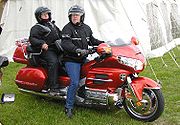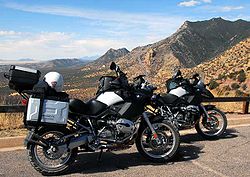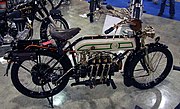Construction
-
Motorcycle construction is the engineering, manufacturing, and assembly of components and systems for a motorcycle which results in performance, cost and aesthetics desired by the designer. With some exceptions, construction of modern mass-produced motorcycles has standardised on a steel or aluminium frame, telescopic forks holding the front wheel, and disc brakes. A gasoline powered engine consisting of between 1 and 8 cylinders coupled to a manual five- or six-speed sequential transmission drives the swingarm-mounted rear wheel by a chain, driveshaft or belt.
Fuel economy
Motorcycle fuel economy benefits from the relatively small mass of the vehicle. This, of course, relates to how the motorcycle is used. One person on a small motorcycle travelling a short distance is generally very economical. However a large motorcycle generally has bad aerodynamics compared with a typical car, poor aerodynamics of exposed passengers and engines designed for goals other than fuel economy can work to reduce these benefits.[citation needed] Riding style has a large effect on fuel economy.
Fuel economy varies greatly with engine displacement and riding style ranging from a low of 29 mpg (US) (12 km/l/35 mpg imp) reported by a Honda VTR1000F rider,[7] to 107 mpg (US) (45 km/l/129 mpg imp) reported for the Verucci Nitro 50 cc Scooter.[8] A specially designed Matzu Matsuzawa Honda XL125 achieved 470 mpg (US) (200 km/l/560 mpg imp) "on real highways - in real conditions."[9]
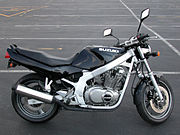
Fuelling
Most of today's fuelling nozzles are designed specifically for automobile and truck fuelling, with the result that fuelling a motorcycle can be somewhat difficult. Fuel can easily overflow or be spilled because the filler necks are exposed and an inefficient seal is formed during fuelling. Also, many of today's fuel nozzles are equipped with sensitive automatic shutoff sensors that are not calibrated for motorcycles; and in the United States the government-required "vapour recovery" nozzles, with their accordion-like rubber outer coverings intended to seal against the vehicle around the fuel port, require the covering to be held back manually with one hand to override the auto shut-off system and permit an uninterrupted flow of fuel to the tank.
[edit] Dynamics
-
Different types of motorcycles have different dynamics and these play a role in how a motorcycle performs in given conditions. For example, a shorter wheelbase would generally make a bike lean faster and would be quicker around corners compared to a longer wheelbase.[citation needed] Longer wheelbase on the other hand provides more stability in a straight line.
Motorcycles must be leaned in order to make turns. This lean is induced by the method known as countersteering, in which the rider presses on the handlebars on the side of the desired direction of turn, but 'steering' the bars in the opposite direction. Because it is counter-intuitive this practice is often very confusing to novices—and even to many experienced motorcyclists.[10]
Short wheelbase motorcycles, such as sport bikes, can generate enough torque at the rear wheel, and enough stopping force at the front wheel, to lift the opposite wheel off the pavement. These actions, if performed on purpose, are known as wheelies and stoppies respectively. If carried past the point of recovery the resulting upset is known as "looping" the vehicle.
Additions
Various features and accessories may be attached to a motorcycle either from the factory or by users.
- Fairing
A plastic or fibreglass shell, known as a "fairing", is placed over the frame on some models to shield the rider from the wind, aid in aerodynamics and protect engine components in an accident. Drag is the major factor that limits motorcycle speed. As evident in the streamlined appearance of new performance motorcycles, there is much aerodynamic technology included in the design. Since the 1958 FIM ban on motorcycle designs that cover the wheels or the rider, e.g., "dustbin" fairings, no major manufacturer has provided fairing to overcome the effect of the turbulence caused by the spinning front wheel, which prevents the motorcycle from cutting a clean path through the air. "Dustbin" fairings can improve aerodynamic performance without substantially compromising the rider's ability to control the machine, if the fairing is designed and tested for the effects of side winds.
Modern fairings on touring and sport-touring motorcycles dramatically improve a rider's comfort and attention on long rides by reducing the effect of the wind and rain on the body. They also help keep a rider warm in cold weather or high wind chill conditions, reducing hypothermia.
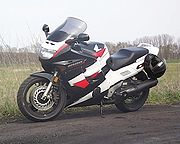
An example of a fairing on a Honda CBR1000F
- Windscreen
Also called windshields or screens, windscreens can be built into a fairing or be attached to an otherwise unfaired bike. They are usually made from transparent high-impact acrylic plastic. They may be shaped specifically to direct air flow over or around the head of the rider even if they are much shorter than the seated rider. Some motorcycles have electric screens, introduced on the 1986 BMW K100LT, which raise and lower the screen with the push of a button to the optimum height for conditions.
In the absence of a fairing or screen, a phenomenon known as the windsock effect occurs at speeds above 100 km/h (62 mph), where the rider becomes a major source of drag and is pushed back from the handlebars, tiring the rider.[citation needed] However, these motorcycles still effectively push their way through the atmosphere with brute force. A cabin cycle, which has a hull that wraps around the basic cycle frame, solved the problem of aerodynamics by isolating driver from outside air.

Craven's
Golden Arrow panniers
- Saddlebags or panniers
Saddlebags or panniers mount on either side of the rear wheel behind the saddle to carry parts, tools, and/or travel gear. They can be made of fiberglass, ABS, leather, Cordura, or other appropriate sturdy material. They are normally standard items on touring motorcycles but are usually optional on other types of motorcycles. They can be model-specific and available from a motorcycle's manufacturer, or after-market and designed to fit on numerous models.

Heated handgrips on a BMW
- Heated hand grips/seats
Since motorcycles lack climate control or proper protection from the wind, some manufacturers offer heated seats or hand grips to relieve the discomfort of low temperatures experienced during night riding or the colder months. They can also be added on as after-market accessories and are powered by the bike's electrical system.
- Luggage rack
A common addition to many bikes is an attachment onto which bags or other luggage can be fastened. This removes the need for rider backpacks and is generally a more secure and safe way to add carrying capacity to a motorcycle.
- Sidecar
A sidecar is a one-wheeled device attached to the side of a motorcycle, producing a three-wheeled vehicle. Early sidecars were removable devices that could be detached from the motorcycle. Sidecars gradually superseded forecars and trailers. The forecar comprised a two-wheeled attachment at the front of the motorcycle. The trailer was just that, pulling the passenger along behind. In neither case could rider and passenger converse easily, and early sidecars were often called 'sociable' attachments.
- Trailer hitch
A trailer hitch or tow hitch is a device mounted on a motorcycle that enables it to tow a motorcycle trailer, usually to haul additional gear. No motorcycle manufacturer recommends trailer towing because it creates safety hazards for motorcyclists.
- Trunk
A motorcycle trunk is a storage compartment in the vicinity of the seat, other than panniers or saddlebags. A trunk mounted above and at the rear of the seat is called a top box.
Social aspects
-
Main article: Motorcycling
Subcultures
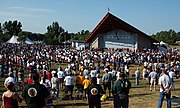
A motorcycle rally in Ontario
Around the world, motorcycles have historically been associated with subcultures. Some of these subcultures have been loose-knit social groups such as the cafe racers of 1950s Britain, and the Mods and Rockers of the 1960s. A few are believed to be criminal gangs.
Social motorcyclist organisations are popular and are sometimes organised geographically, focus on individual makes, or even specific models. Example motorcycle clubs include: American Motorcyclist Association, Harley Owners Group, Moto Guzzi National Owners Club, Gold Wing Road Riders (GWRRA), and BMW MOA.
Many motorcycle organisations raise money for charities through organised events and rides. Some organisations hold large international motorcycle rallies in different parts of the world that are attended by many thousands of riders.
Some other motorcycle organisations exist only for the direct benefit of others. Bikers Against Child Abuse (BACA) is one example. BACA assigns members to individual children to help them through difficult situations, or even stay with the child if the child is alone or frightened.[11]
In recent decades, motorcyclists have formed political lobbying organisations in order to influence legislators to introduce motorcycle-friendly legislation. One of the oldest such organisations, the British Motorcycle Action Group, was founded in 1973 specifically in response to helmet compulsion, introduced without public consultation.[12] In addition, the British Motorcyclists Federation (BMF), originally founded in 1960 as a reaction to the public perception of motorcyclists as leather-jacketed hooligans, has itself moved into political lobbying.
Likewise, the U.S. has ABATE, which, like most such organisations, also works to improve motorcycle safety, as well as running the usual charity fund-raising events and rallies, often for motorcycle-related political interests.[13]
Mobility
While people choose to ride motorcycles for various reasons, those reasons are increasingly practical, with riders opting for a powered two-wheeler as a cost-efficient alternative to infrequent and expensive public transport systems, or as a means of avoiding or reducing the effects of urban congestion.[14] In places where it is permitted, lane splitting, also known as filtering, allows motorcycles to use the space between vehicles to move through stationary or slow traffic.[15]
In the UK, motorcycles are exempt from the £8 per day London congestion charge other vehicles must pay to enter the city during the day. Motorcycles are also exempt from toll charges at some river crossings, such as the Severn Bridge, Dartford Crossing, and Mersey Tunnels. Some cities, such as Bristol, allow motorcycles to use bus lanes and provide dedicated free parking. In the United States, those states that have high-occupancy vehicle lanes also allow for motorcycle travel in them. Other countries have similar policies.
In New Zealand motorcycle riders are not required to pay for parking[16] that is controlled by a barrier arm; the arm does not occupy the entire width of the lane, and the motorcyclist simply rides around it.[17] Many carparks controlled in this way supply special areas for motorcycles to park, so as not to unnecessarily consume spaces.
In many cultures motorcycles are the primary means of motorised transport. According to the Taiwanese government, for example, "the number of automobiles per ten thousand population is around 2,500, and the number of motorcycles is about 5,000."[18]



